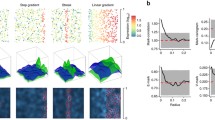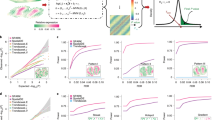Abstract
Motivation: Spatially resolved transcriptomics (SRT) technologies simultaneously measure gene expression and spatial location of cells in a 2D tissue slice, enabling the study of spatial patterns of gene expression.
Cong Ma and Uthsav Chitra contributed equally and author order was decided by a coin toss.
Access provided by Autonomous University of Puebla. Download conference paper PDF
Similar content being viewed by others
Motivation: Spatially resolved transcriptomics (SRT) technologies simultaneously measure gene expression and spatial location of cells in a 2D tissue slice, enabling the study of spatial patterns of gene expression. Current approaches to model spatial variation in gene expression assume either that gene expression is determined by discrete cell types or that gene expression varies continuously across a tissue slice. However, neither of these modeling assumptions adequately represent spatial variation in gene expression: the first assumption ignores continuous variation within a spatial region containing cells of the same type, while the second assumption does not allow for discontinuous changes in expression, e.g., due to a sharp change in cell type composition.
Results: We propose a model of spatial patterns in gene expression that incorporates both discontinuous and continuous spatial variation in gene expression. Specifically, we model the expression of a gene in a layered tissue slice as a piecewise linear function of a single spatial coordinate with potential discontinuities at tissue layer boundaries. We formulate the problem of inferring tissue layer boundaries and gene expression functions for all genes simultaneously. We derive a dynamic programming algorithm to find the optimal boundaries of layers when these boundaries are lines parallel to a coordinate axis. We generalize this algorithm to arbitrarily curved tissue layers by transforming the tissue geometry to be axis-aligned using the theory of conformal maps from complex analysis. We implement these algorithms in a method called Belayer. Applying Belayer to simulated data and to spatial transcriptomics data from the human dorsolateral prefrontal cortex, we demonstrate that Belayer achieves both higher accuracy in clustering tissue layers compared to state-of-the-art SRT clustering methods, and higher accuracy in identifying cortical layer marker genes compared to commonly-used methods for identification of spatially varying genes.
Availability: Software is available at www.github.com/raphael-group/belayer.
Preprint: A preprint of the full manuscript is available at https://doi.org/10.1101/2022.02.05.479261.
Author information
Authors and Affiliations
Corresponding author
Editor information
Editors and Affiliations
Rights and permissions
Copyright information
© 2022 The Author(s), under exclusive license to Springer Nature Switzerland AG
About this paper
Cite this paper
Ma, C., Chitra, U., Zhang, S., Raphael, B.J. (2022). Belayer: Modeling Discrete and Continuous Spatial Variation in Gene Expression from Spatially Resolved Transcriptomics. In: Pe'er, I. (eds) Research in Computational Molecular Biology. RECOMB 2022. Lecture Notes in Computer Science(), vol 13278. Springer, Cham. https://doi.org/10.1007/978-3-031-04749-7_33
Download citation
DOI: https://doi.org/10.1007/978-3-031-04749-7_33
Published:
Publisher Name: Springer, Cham
Print ISBN: 978-3-031-04748-0
Online ISBN: 978-3-031-04749-7
eBook Packages: Computer ScienceComputer Science (R0)




